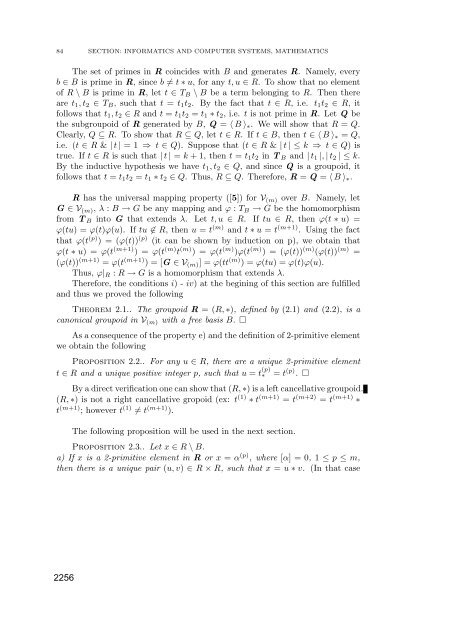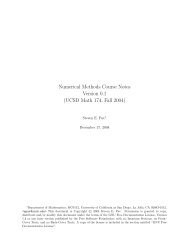FREE OBJECTS IN THE VARIETY OF GROUPOIDS DEFINED BY ...
FREE OBJECTS IN THE VARIETY OF GROUPOIDS DEFINED BY ...
FREE OBJECTS IN THE VARIETY OF GROUPOIDS DEFINED BY ...
Create successful ePaper yourself
Turn your PDF publications into a flip-book with our unique Google optimized e-Paper software.
84 SECTION: <strong>IN</strong>FORMATICS AND COMPUTER SYSTEMS, MA<strong>THE</strong>MATICS<br />
The set of primes in R coincides with B and generates R. Namely, every<br />
b ∈ B is prime in R, since b ≠ t ∗ u, for any t, u ∈ R. To show that no element<br />
of R \ B is prime in R, let t ∈ T B \ B be a term belonging to R. Then there<br />
are t 1 ,t 2 ∈ T B , such that t = t 1 t 2 . By the fact that t ∈ R, i.e. t 1 t 2 ∈ R, it<br />
follows that t 1 ,t 2 ∈ R and t = t 1 t 2 = t 1 ∗ t 2 , i.e. t is not prime in R. Let Q be<br />
the subgroupoid of R generated by B, Q = 〈 B 〉 ∗ . We will show that R = Q.<br />
Clearly, Q ⊆ R. To show that R ⊆ Q, let t ∈ R. Ift ∈ B, then t ∈〈B 〉 ∗ = Q,<br />
i.e. (t ∈ R & | t | =1 ⇒ t ∈ Q). Suppose that (t ∈ R & | t |≤k ⇒ t ∈ Q) is<br />
true. If t ∈ R is such that | t | = k + 1, then t = t 1 t 2 in T B and | t 1 |, | t 2 |≤k.<br />
By the inductive hypothesis we have t 1 ,t 2 ∈ Q, and since Q is a groupoid, it<br />
follows that t = t 1 t 2 = t 1 ∗ t 2 ∈ Q. Thus, R ⊆ Q. Therefore, R = Q = 〈 B 〉 ∗ .<br />
R has the universal mapping property ([5]) for V (m) over B. Namely, let<br />
G ∈V (m) , λ : B → G be any mapping and ϕ : T B → G be the homomorphism<br />
from T B into G that extends λ. Let t, u ∈ R. If tu ∈ R, then ϕ(t ∗ u) =<br />
ϕ(tu) =ϕ(t)ϕ(u). If tu ∉ R, then u = t (m) and t ∗ u = t (m+1) . Using the fact<br />
that ϕ(t (p) )=(ϕ(t)) (p) (it can be shown by induction on p), we obtain that<br />
ϕ(t ∗ u) =ϕ(t (m+1) )=ϕ(t (m) t (m) )=ϕ(t (m) )ϕ(t (m) )=(ϕ(t)) (m) (ϕ(t)) (m) =<br />
(ϕ(t)) (m+1) = ϕ(t (m+1) )=[G ∈V (m) ]=ϕ(tt (m) )=ϕ(tu) =ϕ(t)ϕ(u).<br />
Thus, ϕ| R : R → G is a homomorphism that extends λ.<br />
Therefore, the conditions i) -iv) at the begining of this section are fulfilled<br />
and thus we proved the following<br />
Theorem 2.1.. The groupoid R =(R, ∗), defined by (2.1) and (2.2), is a<br />
canonical groupoid in V (m) with a free basis B. □<br />
As a consequence of the property e) and the definition of 2-primitive element<br />
we obtain the following<br />
Proposition 2.2.. For any u ∈ R, there are a unique 2-primitive element<br />
t ∈ R and a unique positive integer p, such that u = t ∗<br />
(p) = t (p) . □<br />
By a direct verification one can show that (R, ∗) is a left cancellative groupoid.<br />
(R, ∗) is not a right cancellative gropoid (ex: t (1) ∗ t (m+1) = t (m+2) = t (m+1) ∗<br />
t (m+1) ; however t (1) ≠ t (m+1) ).<br />
The following proposition will be used in the next section.<br />
Proposition 2.3.. Let x ∈ R \ B.<br />
a) If x is a 2-primitive element in R or x = α (p) , where [α] =0, 1 ≤ p ≤ m,<br />
then there is a unique pair (u, v) ∈ R × R, such that x = u ∗ v. (In that case<br />
2256














